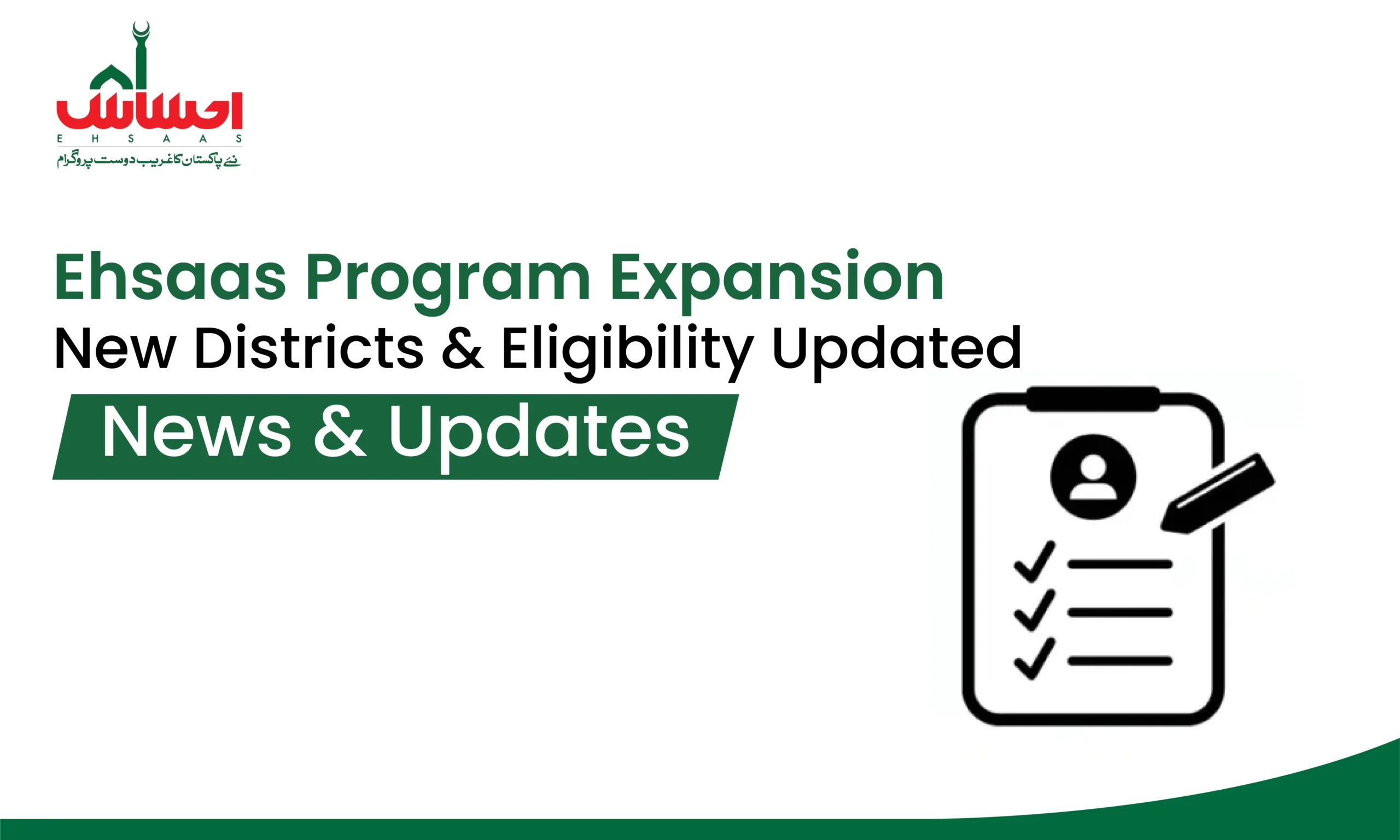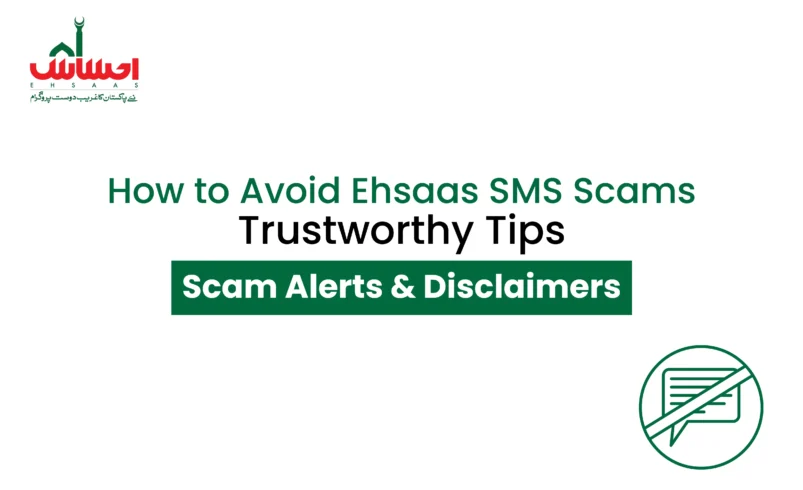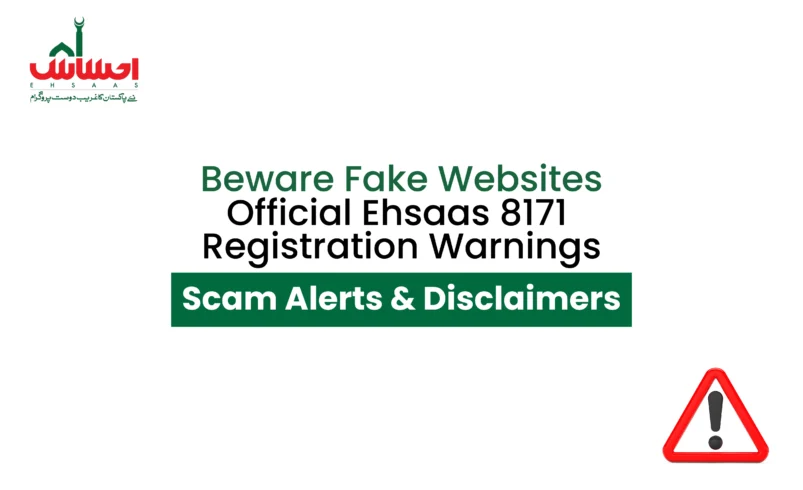Ehsaas Program has now become the lifeline of the millions of Pakistani families giving them the much-needed financial support through its 8171 SMS registration system. The increasing number of individuals who use the services has attracted criminals to develop new methods of exploiting beneficiaries using advanced SMS scams, which may wipe out bank accounts and steal personal details.
Text message scams have become more realistic, and many of them can look like they are being sent by an official governmental number and ask sensitive information or lead the recipient to fraudulent websites. New eligibility rules and increased program expansions have made scammers target both old beneficiaries and those who are new applicants and are not aware of the red flags.
This guide will provide you with all the information you require to know how to recognize valid Ehsaas communications, secure your personal data and report suspicious activities. Knowledge of these tricks does not only save you financially but also saves your whole community against being a victim of these fraudulent plans.
Understanding the Common Scam Tactics
The SMS scammers that aim at Ehsaas beneficiaries use a number of advanced techniques that are meant to seem genuine but at the same time, steal useful personal information. One of the most widespread methods is payment verification scams, when the criminals send messages that your benefits are suspended because of the absence of payment confirmations. The texts are usually written in desperate language that requires you to act urgently to reactivate your account status.
Account reactivation plans are the scam schemes that give the impression of an emergency that your Ehsaas registration has lapsed or has gone inactive. The scammers send official-looking messages that the beneficiaries have to confirm their details within a certain period to receive more payments. These are strategies that take advantage of the fear of losing the much needed financial aid by the recipients.
Pseudo survey requests come in the form of authentic government messages requesting the beneficiaries to fill in satisfaction surveys or to provide their demographic data. These messages usually offer bonus payment or guaranteed benefit increase in exchange of participation. Although they seem to be useful, such surveys gather detailed personal information that can be used by the criminals to commit identity thefts.
Phishing links in fraudulent messages lead to the page of the fake websites that replicate the official government websites. The sites steal usernames and passwords, bank details, and identity papers as the users log in to their accounts. The advanced nature of these fraudulent websites is what makes them so risky to unsuspecting beneficiaries.
Recognizing Genuine Ehsaas Communications
Original Ehsaas SMS messages are of particular format and have verifiable information that makes them different to fraud messages. Authoritative messages are always directed by the recognized 8171 system and are made in standardized language accepted by the government. Such messages do not ask the recipients to provide personal details via text messages or click links to verify their accounts.
Authorized status messages give definite details of payment schedules, eligibility verification, or program announcements but do not seek any action on the part of the beneficiaries. Formal SMS messages are professional and do not use language that seeks to cause panic or impose some urgency to act. Government messages also mention particular aspects of the program that can be checked by the recipients via official sources.
True communications contain proper identification of the sending agency and give official contact details to allow verification. These messages do not pose a threat of suspension of the account and do not require taking action to preserve the status of benefits. Genuine SMS issued by the government never contains any spelling mistakes, unofficial abbreviations, and unprofessional formats that can signal fraudulent origin.
Verified communication channels bring official program updates at once, so that verified information will be published on government websites, verified social media accounts, and through established media partnerships at the same time SMS notifications are distributed. This uniformity enables the beneficiaries to compare information on various official sources.
Tips for Verifying SMS Authenticity
Make sure that the message is verified by the government before acting on any SMS pertaining to Ehsaas. Report to the helplines that have been put in place on official government websites to ascertain that the communication was initiated by official sources. Authorized representatives are able to make a swift check of the correspondence of particular messages to the present-day program communications.
Compare the content of messages with the data that can be found on official government websites. Verified portals show official updates of a program, payment schedules, and policy changes before or at the same time as the SMS notifications. Any message that carries information that is not present on official sites should be considered as possible fraud.
Compare the phone number of the sender with the government communication records. Legitimate Ehsaas messages are sent on numbers that are given by the government and do not change with time. Be wary of any messages that are sent by other numbers and in particular by standard mobile formats instead of official short codes.
Avoid clicking links in suspicious SMS messages which may seem to be directing to official websites. Rather, go to trusted government websites by directly entering government web addresses in your browser. This will avoid landing on fraudulent sites that are meant to steal your login details or personal information.
Protecting Your Personal Information
Protect your CNIC number, phone number, and banking information as a treasured item that thieves are keen to find. Do not give full identity details in SMS responses even when the messages seem to be official. Government communications that are legitimate do not demand sensitive personal information via text messages.
Make passwords robust, unique and do not use the same passwords on different platforms, especially on the accounts that are official to the government. Where two-factor authentication is offered on an official government site, turn it on to provide additional security to your account access. Such steps greatly decrease the chances of an unauthorized access to the account.
You should check your bank accounts frequently to see whether there are unauthorized transactions that could be a sign of stolen financial data. Ensure that you set up account alerts with your banking institution so that you can get notified when there is unusual activity. The fraudulent transactions are detected quickly that enables faster resolution and the larger financial losses are averted.
Maintain documentation of all the valid Ehsaas correspondence, such as official SMS, confirmation of payments, and program notifications. This record assists you to identify the trends in genuine communications and can be used as a source of reference to determine the suspicious messages that do not follow the set formats.
Effective Reporting of Suspicious Messages
In case of an identification of a fraudulent Ehsaas SMS message, report it to the Federal Investigation Agency (FIA) Cyber Crime Wing without any delay. The FIA has special hotlines and online reporting systems reserved to SMS fraud and identity theft cases. Timely reporting assists the authorities to monitor criminal networks and possibly rescue other victims who might be victims to the same schemes.
Send suspicious messages to the authorized administrators of the official Ehsaas program using valid government contact points. These reports enable the program officials to give the general warning on active scam campaigns and update security procedures to safeguard beneficiaries. Your reports help in the protection of the community at large.
Record any attempts of scam by making screenshots of fake messages and save any correspondence. Write down the phone number of the sender, the time of the message and other information regarding suspicious contact attempts. This record helps the law enforcement agencies to construct complete cases against criminal operators.
Report spam messages to your mobile service provider and ask to block the numbers of fraudulent communications. The majority of the telecommunications providers have fraud prevention departments that are able to scan suspicious messaging patterns and provide their subscribers with protective measures.
Staying Informed About New Scams
Fraudsters keep devising new methods to target Ehsaas beneficiaries and regular training is, therefore, necessary to ensure security. Follow government communication channels such as verified social media accounts and email newsletters to get up-to-date information on new threats and security advice.
Engage in the community awareness initiatives on digital literacy and scam prevention. Educational sessions are frequently held by local government offices and NGOs, where people are taught how to recognize and prevent the most common fraud schemes and obtain practical skills. Such programs also establish communities of knowledgeable citizens who can pass warnings of ongoing scam campaigns.
Keep abreast of the changes in the program and policy updates via the official sources instead of informal sources or social media rumors. Criminals usually take advantage of the confusion that arises when there is a change in the programs and initiate specific scam campaigns. Knowing the legitimate operations of a program assists you to identify when there are communications that are not in line with the procedures.
Follow the news and the government announcements regarding the trends of cybercrimes on social benefit programs. The coverage of successful prosecution of scams and new criminal methods by media is a good source of information about the emerging threats that could be used against Ehsaas recipients. This knowledge can make you identify and prevent the emergence of new fraud schemes.
Your Defense Against SMS Scams
The best way to guard against Ehsaas SMS scams is to be cautious, verify and act quickly when you receive a dubious message. With the increased scope of digital benefits programs, there are new opportunities to receive legitimate help and criminal abuse. Learning the tricks of scammers, knowing how to identify genuine messages, and adhering to the steps of a correct verification, you will be able to use the services you need and deserve without jeopardizing your personal and financial safety.
Note that any government program that is legitimate would not be interested in the security of the beneficiaries, and will not apply high-pressure tactics or urge them to submit personal information within a tight deadline. Whenever you are getting any SMS, whether it is asking you to take any action or it is asking you to provide any sensitive information, take time to check the communication using official channels before acting on it. Your precaution does not only safeguard your personal interests, but also helps in building security awareness in the community.
Report any suspicious behaviors as soon as they are noticed and educate family members and neighbors on the most common scams. The united watchdogs develop a formidable shield against criminal activities that exploit needy families in search of genuine government help. Be alert, be aware, and contribute to making a safer world to all Ehsaas beneficiaries.






